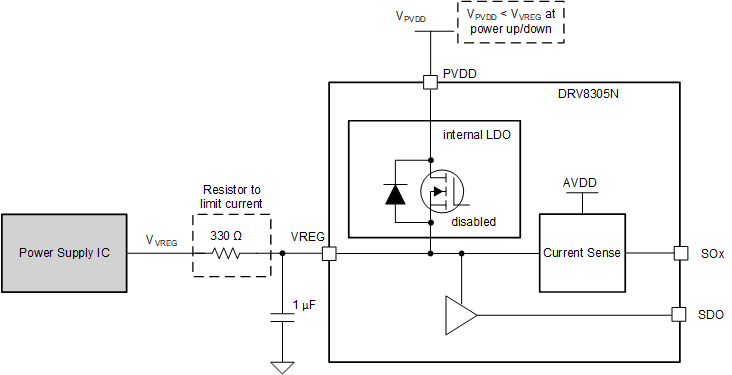JAJSHP7D May 2015 – July 2019 DRV8305-Q1
PRODUCTION DATA.
- 1 特長
- 2 アプリケーション
- 3 概要
- 4 改訂履歴
- 5 概要(続き)
- 6 Pin Configuration and Functions
- 7 Specifications
-
8 Detailed Description
- 8.1 Overview
- 8.2 Functional Block Diagram
- 8.3
Feature Description
- 8.3.1 Integrated Three-Phase Gate Driver
- 8.3.2 INHx/INLx: Gate Driver Input Modes
- 8.3.3 VCPH Charge Pump: High-Side Gate Supply
- 8.3.4 VCP_LSD LDO: Low-Side Gate Supply
- 8.3.5 GHx/GLx: Half-Bridge Gate Drivers
- 8.3.6 DVDD and AVDD: Internal Voltage Regulators
- 8.3.7 VREG: Voltage Regulator Output
- 8.3.8 Protection Features
- 8.3.9 Undervoltage Warning (UVFL), Undervoltage Lockout (UVLO), and Overvoltage (OV) Protection
- 8.4 Device Functional Modes
- 8.5 Programming
- 8.6
Register Maps
- 8.6.1 Status Registers
- 8.6.2
Control Registers
- 8.6.2.1 HS Gate Drive Control (Address = 0x5)
- 8.6.2.2 LS Gate Drive Control (Address = 0x6)
- 8.6.2.3 Gate Drive Control (Address = 0x7)
- 8.6.2.4 IC Operation (Address = 0x9)
- 8.6.2.5 Shunt Amplifier Control (Address = 0xA)
- 8.6.2.6 Voltage Regulator Control (Address = 0xB)
- 8.6.2.7 VDS Sense Control (Address = 0xC)
- 9 Application and Implementation
- 10Power Supply Recommendations
- 11Layout
- 12デバイスおよびドキュメントのサポート
- 13メカニカル、パッケージ、および注文情報
パッケージ・オプション
メカニカル・データ(パッケージ|ピン)
- PHP|48
サーマルパッド・メカニカル・データ
- PHP|48
発注情報
9.2.3 VREG Reference Voltage Input (DRV8305N)
For the DRV8305N, the VREG pin is used for a reference voltage of current sense amplifier and SDO pullup as described in VREG: Voltage Regulator Output. The internal LDO is disabled, but the LDO physically exists in the device, and there is a current path from the VREG pin to the PVDD pin through the internal LDO. The reference current specified in the data sheet flows to the device if PVDD voltage (VPVDD) is higher than VREG pin voltage (VVREG). In case VVREG is higher than VPVDD during power up/down sequence, TI recommends to limit the current by adding a resistor to VREG pin so that the current does not exceed 50 mA. As shown in Figure 19, a 330-Ω resistor helps limit the current to approximately 15 mA when VVREG = 5 V and VPVDD = 0 V. For VVREG = 3.3 V, TI recommends to use 220 Ω.
 Figure 19. VREG Reference Voltage Input
Figure 19. VREG Reference Voltage Input